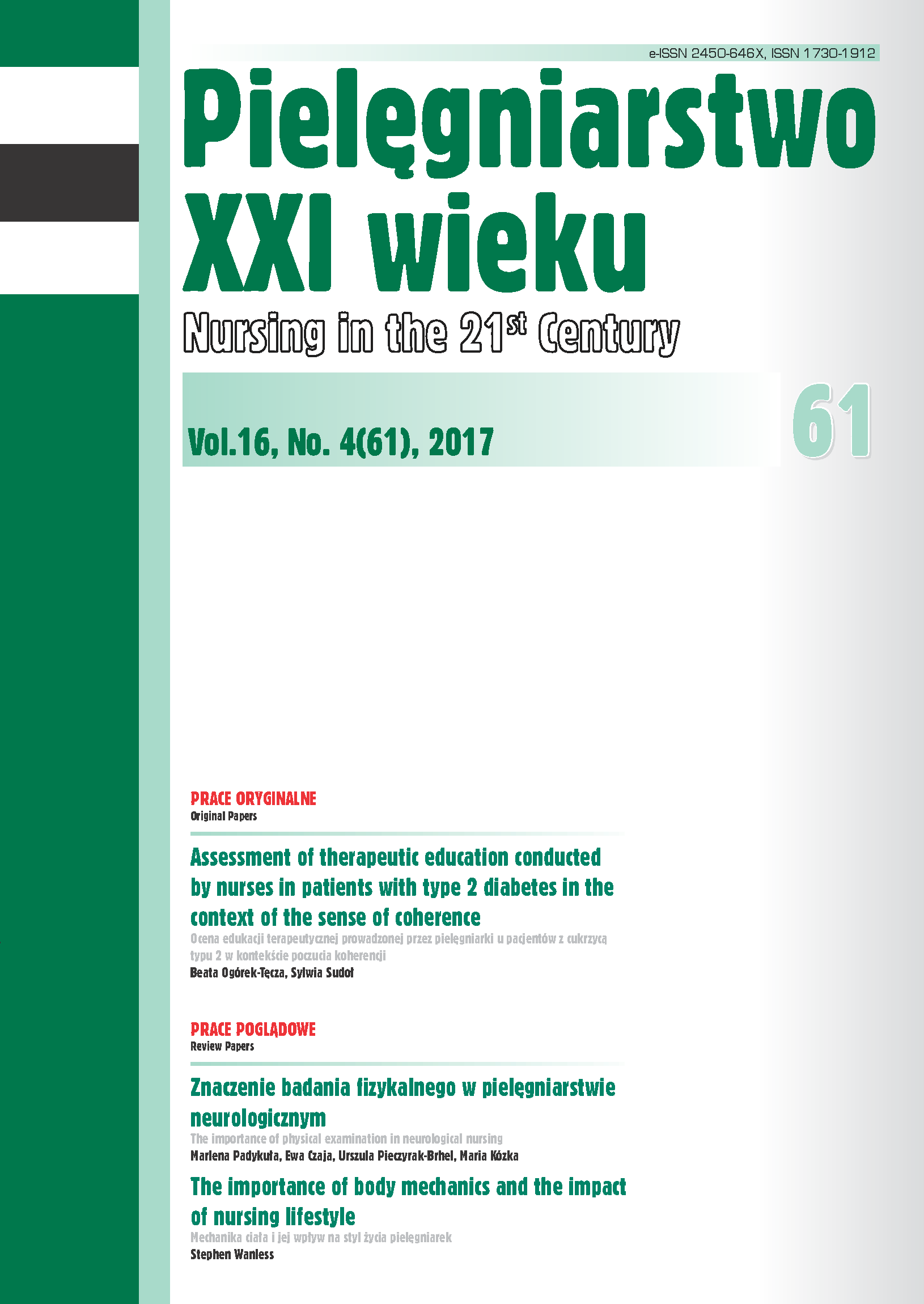Mechanika ciała i jej wpływ na styl życia pielęgniarek
DOI:
https://doi.org/10.1515/pielxxiw-2017-0038Słowa kluczowe:
mechanika ciała, sposób podnoszenia i przemieszczania, zmiana stylu życiaAbstrakt
MECHANIKA CIAŁA I JEJ WPŁYW NA STYL ŻYCIA PIELĘGNIAREK
Personel pielęgniarski częściej cierpi na bóle w kręgosłupie dolnym niż jakakolwiek inna grupa zawodowa, częstość różni się w zależności od kraju. Aktywności związane z pracą, takie jak schylanie się, obracanie, częste podnoszenie ciężarów, niewygodna postawa ciała oraz stres psychologiczny, są uważane za czynniki powodujące różne urazy kręgosłupa. Działania zapobiegawcze, które powinny być podejmowane w celu redukowania ryzyka bólów kręgosłupa dolnego zawierają, między innymi, ustalanie odpowiednich okresów odpoczynku, wprowadzanie programów edukacyjnych dostarczających wiedzy na temat poprawnego używania mechaniki ciała, wprowadzanie programów zmiany stylu życia.
Bibliografia
1. Cheung KMC. The relationship between disc degeneration, low back pain, and human pain genetics. The Spine Journal. 2010;10 (11) : 958-960.
2. June KJ, Cho S. Low back pain and work-related factors among nurses in intensive care units. Journal of Clinical Nursing. 2011; 20 (3): 479-487.
3. Castro AB. Handle with Care: The American Nurses Association’s Campaign to Address Work-Related Musculoskeletal Disorders. Orthopaedic Nursing. 2006; 25 (6): 356-365.
4. de Souza Petersen R, Marziale MHP. Low back pain characterized by muscle resistance and occupational factors associated with nursing. Revista Latino-Americana de Enfermagem. 2014; 22 (3): 386-393.
5. Lind A, Gard G. Harmful Effects in Personal Assistants Client Transfer Situations. The Ergonomics Open Journal. 2014; 7: 1-5.
6. Bonzini M, Bertu L, Veronesi, G, et al. Is musculoskeletal pain a consequence or a cause of occupational stress? A longitudinal study. International Archives of Occupational and Environmental Health. 2015; 88 (5): 607-612.
7. Wanless S. Improving the effectiveness of motor skills learning in moving and handling training for the healthcare environment. Unpublished PhD thesis, 2015.
8. Waters TR, Dick RB. Evidence of Health Risks Associated with Prolonged Standing at Work and Intervention Effectiveness. Rehabilitation Nursing. 2014; 40 (3): 148-165.
9. Bevan S. Economic impact of musculoskeletal disorders (MSDs) on work in Europe. Best Practice & Research Clinical Rheumatology. 2015; 29 (3): 356-373.
10. Parent-Thirion A. Vermeylen G, van Houten G, et al. Eurofound project: Fifth European Working Conditions Survey. The European Foundation for the Improvement of Living and Working Conditions. Luxembourg, 2012.
11. Ng D, McNee C, Kieser K, Farella M. Neck and shoulder muscle activity during standardized work-related postural tasks. Applied Ergonomics. 2014; 45 (3): 556-563.
12. Smedley J, Williams S, D’Arcy P, et al. Back pain management: Occupational health practice in the NHS in England. A national clinical audit – round 2. Royal College of Physicians. London, 2012.
13. Boorman S. NHS Health and Well-being – Final Report. Dept of Health, London, 2009.
14. Health & Safety Executive. Work related Musculoskeletal Disorders (WRMSDs) Statistics in Great Britain 2017. HMSO. London, 2017.
15. Wanless S. Principles for the Safe Moving and Handling of Patients. Nursing in the 21st Century. 2017; 15 (4): 66-69.
16. Thomas JR, Nelson JK, Silverman SJ. Research Methods in Physical Activity, 7th Ed. Champaign, IL. Human Kinematics, 2015.
17. Karimi MT, Solomonidis S. The relationship between parameters of static and dynamic stability tests. Journal of Research in Medical Sciences. 2011; 16 (4): 530-535.
18. Patel K. Complete Guide to Postural Training. London. Bloomsbury Ltd, 2014.
19. Bond M. The New Rules of Posture: How to sit, stand and move. Rochester. Healing Arts Press, 2007.
20. Dangerfield P. Chapter 4: Assessment of posture. In Eston, R. Riley, T. (Eds) (2009) Kinanthropometry and Exercise Physiology Laboratory Manual: Tests, Procedures and data, third Edition, Volume one: Anthropometry. London; Routledge, 2009.
21. Hirshkowitz M, Whiton K, Albert SM, et al. National Sleep Foundation’s sleep time duration recommendations: methodology and results summary. Sleep Health. 2015; 1 (1): 40-43.
Opublikowane
Numer
Dział
Licencja
Prawa autorskie (c) 2017 Autor

Praca jest udostępniana na licencji Creative Commons Attribution-NonCommercial-NoDerivatives 3.0 Unported License.




